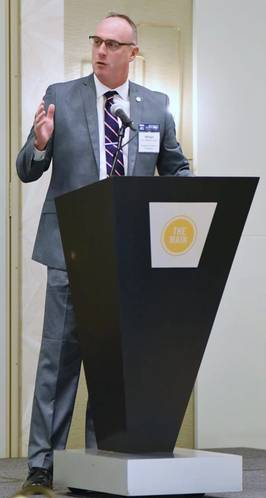AWIA/WRDA Overwhelmingly Passes in Senate
Bill now heads to White House for President Trump’s signature.
Today, the Senate voted 99-1 in favor of America’s Water Infrastructure Act of 2018/Water Resources Development Act, otherwise known as WRDA 2018. The Bill passed in the U.S. House by unanimous voice vote (435-0) in August.
“The passage of WRDA 2018 is a win for the Nation’s towboat operators, freight shippers, ports and labor and conservation groups that rely on an efficient inland waterways system,” said Mike Toohey, President and CEO of the Waterways Council, Inc. (WCI). “This bill strengthens our Nation’s vital inland waterways transportation system, will create and sustain American jobs, increase exports, and keep the United States competitive in world markets.”
William P. Doyle, CEO and Executive Director of the Dredging Contractors of America said, “America needs this comprehensive water infrastructure legislation.” Doyle continued, “This legislation cuts bureaucratic red tape, it creates jobs and keeps our coastal communities, ports, harbors and inland waterway system safe. It will grow the nation’s economy and speed up important projects. We look forward to President Trump signing the legislation into law.”
WRDA 2018 authorizes at least $9 billion for Army Corps of Engineers civil-works projects and Environmental Protection Agency drinking-water and sewer-overflow control programs. These authorizations still require annual appropriations before construction contracts for projects can move forward.
A central part of the measure is a new Water Resources Development Act title, which authorizes $3.7 billion in federal funds for 12 Corps dredging, flood protection and other projects. When non-federal funding shares are added, those projects' combined is about $5.6 billion. This includes $2.2 billion for flood protection and ecosystem restoration along the Texas Gulf Coast.
In addition, the WRDA title includes enhanced funding for already the under-construction projects for the deepening of Savannah Harbor in Georgia and replacement for the Chickamauga Lock on the Tennessee River.
Salient points of America’s Water Infrastructure Act of 2018/Water Resources Development Act:
- Ensure that America maintains the competitiveness of our coastal and inland ports, and maintain the navigability of our inland waterways;
- Create a new framework to allow for more Army Corps projects to be budgeted with increased local stakeholder input and expanded transparency;
- Beneficial use of dredged material - increases the number of authorized pilot projects from 10 to 20;
- Authorize or reauthorize important water infrastructure programs and projects;
- Include billions of dollars in deauthorizations – making the legislation fiscally responsible;
- Authorize federal funding for water infrastructure projects, which leverages billions in water infrastructure spending;
- Reduce flooding risks for rural, western, and coastal communities.
AWIA continues the process, established in the 2014 water resources legislation, of enacting a WRDA bill every two years. This enables navigation channel improvements to be studied, authorized and constructed in a timely and efficient manner, utilizing new guidance that is critical to the nation’s efficient freight movement and economic growth.
In addition to authorizing three coastal navigation channel improvement projects (benefitting the ports of Seattle, Galveston and San Juan, PR) to proceed to construction, the new legislation approves modifications to authorized navigation projects in Savannah, Ga., Norfolk, Va., and Sault St. Marie/Soo Locks, Mich. It also expedites qualifying projects currently under study to proceed into the preliminary engineering and design phase, benefitting the Port of Tacoma, tributaries leading to the Port of New York and New Jersey, and ports in Houma, Baptiste Collette and Bayou LaFourche, La., and Nome, Alaska.
Furthermore, S. 3021 directs the U.S. Army Corps of Engineers to provide technical assistance when requested for sponsor-led navigation channel improvement studies, benefitting ports in Port Canaveral, Fla.; Wilmington, NC; Savannah, Ga.; and Port Fourchon, Houma, Baptiste Collette and Bayou LaFourche, La. It also directs the Corps to maintain and provide a “balance sheet” on cost-shared funding efforts to address dredged-material placement facility cost-share issues, which benefits Port Houston and other Texas ports.
“By overwhelmingly approving AWIA 2018 today, we commend the Senate for helping ensure that crucial water resources legislation is addressed and passed by Congress on an every-two-year basis,” said Kurt Nagle, President and CEO of the American Association of Port Authorities (AAPA). “Today’s AWIA passage continues the trend of streamlining maritime infrastructure improvements by expediting evaluations, enabling timely decisions and providing greater funding flexibilities, as well as authorizing new projects.”
Included in the AWIA is the Soo Lock Post-Authorization Change Report, which authorizes construction of a second Poe-sized lock at Sault Ste. Marie, Michigan, to move forward. The new lock is projected to cost approximately $922 million and take seven years to build. In April, President Trump declared his support for “fixing” the Soo Locks.
The locks at Sault Ste. Marie, Michigan, connect Lake Superior to the lower four Great Lakes. In a typical year, as much as 80 million tons of cargo pass through the Soo Locks. However, roughly 90 percent of that cargo transits the Poe Lock. The other lock, the MacArthur, is too small to accommodate the most efficient ships in the fleet.
“The American steel industry gets all its waterborne domestic iron ore through the Soo Locks,” said James H.I. Weakley, President of Lake Carriers’ Association, the trade association representing U.S.-flag vessel operators on the Great Lakes. “A Department of Homeland Security study found that if the Poe Lock went down for six months, domestic steel production would grind to a halt and 11 million Americans lose their jobs. A second Poe-sized lock is critical to our nation’s economic well-being and national defense capabilities.”














